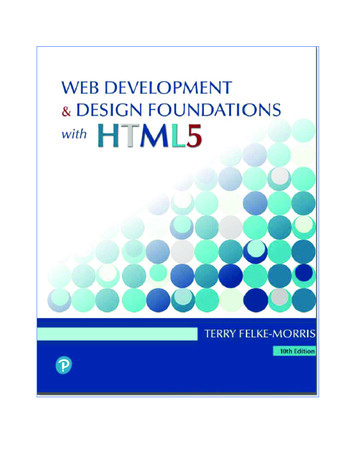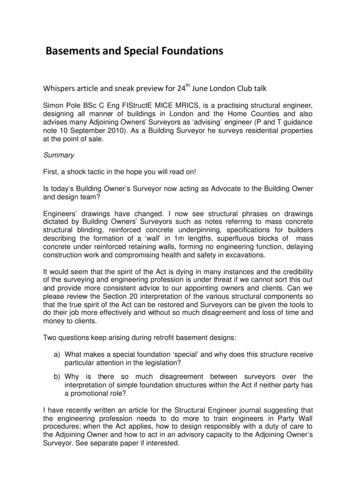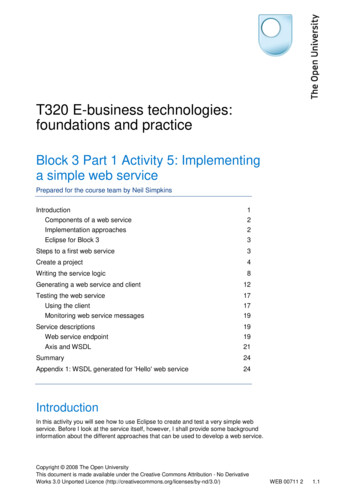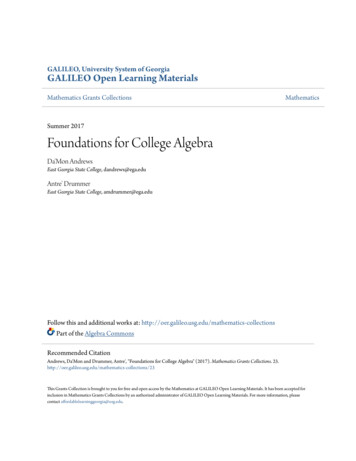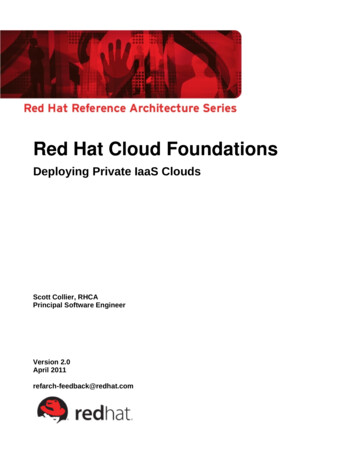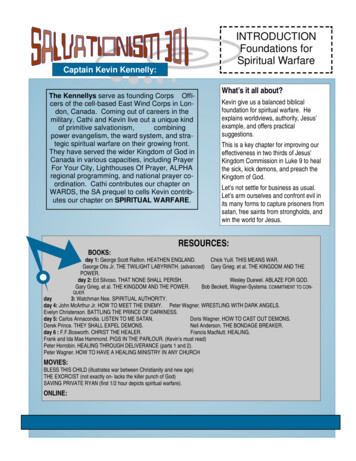
Transcription
Lecture Note COSC 421(M.E. Haque)1TYPES OF FOUNDATIONSFoundation SystemsShallow FoundationDeep FoundationPile FoundationIsolated spreadfootingsWall footingsCombinedfootingsPier (Caisson)FoundationCantilever orstrap footingsRaft or Matfoundation
Lecture Note COSC 421(M.E. Haque)2Shallow Foundations – are usually located no more than 6 ft below the lowestfinished floor. A shallow foundation system generally used when (1) the soil close theground surface has sufficient bearing capacity, and (2) underlying weaker strata do notresult in undue settlement. The shallow foundations are commonly used mosteconomical foundation systems.Footings are structural elements, which transfer loads to the soil from columns, wallsor lateral loads from earth retaining structures. In order to transfer these loads properly tothe soil, footings must be design to Prevent excessive settlementMinimize differential settlement, andProvide adequate safety against overturning and sliding.Types of FootingsColumnFootingIsolated spread footings under individual columns.These can be square, rectangular, or circular.
Lecture Note COSC 421(M.E. Haque)3WallFootingWall footing is a continuous slab strip along thelength of wall.
Lecture Note COSC 421(M.E. Haque)4ColumnsFootingCombined FootingProperty lineCombined footings support two or more columns. These canbe rectangular or trapezoidal plan.
Lecture Note COSC 421(M.E. Haque)5Property lineCantilever or strap footings: These are similar to combinedfootings, except that the footings under columns are builtindependently, and are joined by strap beam.
Lecture Note COSC 421(M.E. Haque)6ColumnsFootingMat or RaftRaft or Mat foundation: This is a large continuous footingsupporting all the columns of the structure. This is used whensoil conditions are poor but piles are not used.
Lecture Note COSC 421(M.E. Haque)7Deep Foundations – The shallow foundations may not be economical or evenpossible when the soil bearing capacity near the surface is too low. In those cases deepfoundations are used to transfer loads to a stronger layer, which may be located at asignificant depth below the ground surface. The load is transferred through skin frictionand end bearing (Figure below).PSkin frictionWfHard soil/BedrockEnd bearingFig. 1(a) Axial Compressive Load transfer in deep foundationsPSkin frictionWfEnd bearing (negligible)Fig. 1(b) Axial Compressive Load transfer in deep foundations
Lecture Note COSC 421(M.E. Haque)8PSkin frictionWfFig. 2 Axial Tension Load transfer in deep foundationsVMFig. 3 Lateral Load transfer in deep foundations
Lecture Note COSC 421(M.E. Haque)9ColumnColumnPiles capPiles capPiles(a)Piles(b)Fig. Pile Foundation- (a) Vertical Piles; (b) Battered Piles
Lecture Note COSC 421(M.E. Haque)10ColumnPile CapPilesPile Foundation
Lecture Note COSC 421(M.E. Haque)11ColumnPier shaftBellPier Foundation (Caisson)
Lecture Note COSC 421(M.E. Haque)12Soil properties and parameters, and Foundation SystemsFrost Depth (Frost Line or Freezing Depth) —is the depth to which thegroundwater in soil is expected to freeze due to temperature drop.The frost line varies by latitude; it is deeper closer to the poles.It ranges in the United States from about zero to six feet.Below that frost depth the temperature varies, but is always above 0 C (32 F).In Arctic and Antarctic locations the freezing depth is so deep that itbecomes year-round permafrost, and the term "thaw depth" is used instead.[Reference: http://en.wikipedia.org/wiki/Frost line ]Frost Depth in USA
Lecture Note COSC 421(M.E. Haque)13Frost heaving is an upwards swelling of soil during freezing conditionscaused by an increasing presence of ice as it grows towards the surface. Ice growth requires a water supply that delivers water to the freezingfront via capillary action in certain soils. The weight of overlying soil restrains vertical growth of the ice andcan promote the formation of lens-shaped areas of ice within the soil. Yet the force of one or more growing ice lenses is sufficient to lift alayer of soil, as much as 30 cm or more. The soil through which water passes to feed the formation of icelenses must be sufficiently porous to allow capillary action, yet not soporous as to break capillary continuity. Such soil is referred to as"frost susceptible". Differential frost heaving can crack pavements—contributing tospringtime pothole formation—and damage building foundations.[Reference: http://en.wikipedia.org/wiki/Frost heaving ]
Lecture Note COSC 421(M.E. Haque)14Capillary action (capillarity, capillary motion, or wicking) is the ability of aliquid to flow in narrow spaces without the assistance of, and in oppositionto, external forces like gravity.If the diameter of the tube is sufficiently small, then the combination ofsurface tension caused by cohesion within the liquid and adhesive forcesbetween the liquid and the tube act to lift the liquid (Figure).The capillary action is due to the pressure of cohesion and adhesion, whichcause the liquid to work against gravity.[Reference: http://en.wikipedia.org/wiki/Capillary action ]High capillary riseLow capillary riseWater
Lecture Note COSC 421(M.E. Haque)15Soil Bearing Pressure at base of FootingsA. Concentrically Loaded FootingPBearing pressure, p P/A P/(W x L)WL
Lecture Note COSC 421(M.E. Haque)16B. Eccentric load on FootingsCASE I ( e1 L/6)e1PpminpmaxL/6L/6W/6WW/6Kern BoundaryL
Lecture Note COSC 421(M.E. Haque)17CASE II ( e1 L/6)e1PPmin 0pmaxL/6LoadW/6WL/6W/6Kern BoundaryL
Lecture Note COSC 421(M.E. Haque)CASE I ( e1 L/6)Direct Stress Bending Stressp min Direct Stress – Bending Stressp max Direct Stress Bending Stressp min (P/A) – (M . c / I)p max (P/A) (M . c / I)whereA W x LM P x e1c L/2I W x L3 /12c/I (L/2) x 12/(W x L3) 6/(W x L2)Therefore,p min P/(W x L) – 6(P x e1) /(W x L2)p max P/(W x L) 6(P x e1) /(W x L2)CASE II ( e1 L/6)Direct Stress Bending Stress(P/A) (M . c / I)P/(W x L) 6(P x e1) /(W x L2)Therefore, e1 L/6p min 0p max P/(W x L) 6(P x L/6) /(W x L2) 2P/(W x L)18
Lecture Note COSC 421(M.E. Haque)19CASE III ( e1 L/6)PL/2e1X (L/2 – e1)Pmin 0pmaxL/6L/6LoadW/6WW/6Kern BoundaryL
Lecture Note COSC 421(M.E. Haque)20CASE III ( e1 L/6)As shown above, as the load, P acts outside of the kern boundary,tensile stress results at the left side.For pmax less than allowable soil bearing capacity, no uplift isexpected at the left end of the footing, and the center of gravity of thetriangular bearing stress distribution coincides with the point of actionof load, P.Downward Load Area of upward triangular stress block x widthP ½ (pmax) (3X)WP 3/2 (pmax) (L/2 – e1) WPmax 2P / [3W(L/2 – e1)]
Lecture Note COSC 421(M.E. Haque)21C. Biaxial loading of FootingYexWeyLoad,PXLBiaxial Loading (Eccentricity about two axes):Bearing Stresses at the corners of the footing are –p P/(W.L) (P. ex . Cx)/Iy (P. ey . Cy)/IxwhereCx L/2; Cy W/2;Ix L. W3 /12; Iy W. L3 /12
Lecture Note COSC 421(M.E. Haque)22PMee M/PP
Lecture Note COSC 421(M.E. Haque)23EXAMPLE 1:A reinforced concrete footing (Fig 1) supports a 12”x12” column reaction P 100 kips atthe top of footing. Based on the soil test, allowable bearing capacity of soil is 5 ksf.Check the adequacy of the footing based on bearing pressure.Slab on grade, surcharge weight 120 psfSoil unit weight 110 pcf4’-0”P 100kFrost line2’-0”5ft5ft
Lecture Note COSC 421(M.E. Haque)24Solution:Since the footing is concentrically loaded, soil bearing pressure is considereduniformly distributed assuming the footing is rigid.Column load 100 kFooting weight (5x5x2)x150/1000 7.5 kSoil weight [(5x5) - (1x1)]x4x110/1000 10.56 kSlab on grade surcharge weight [(5x5)-(1x1)]x120/1000 2.88--------------------------Total weight on soil 120.94 kSoil pressure p 120.94/(5x5) 4.84 ksf allowable bearing pressure 5 ksf.OK
Lecture Note COSC 421(M.E. Haque)25EXAMPLE 2:A reinforced concrete footing (Fig 2) supports a 12”x12” column reaction P 100 kips atthe top of footing. Based on the soil test, allowable bearing capacity of soil is 5 ksf.Check the adequacy of the footing based on bearing pressure.Slab on grade, surcharge weight 120 psfSoil unit weight 110 pcf4’-0”P 100kM 50 k-ftFrost line2’-0”5ft7ft
Lecture Note COSC 421(M.E. Haque)26Solution:Eccentricity, e M/P 50/100 0.5 ft (L/6 7/6 1.1667 ft)CASE I ( e1 L/6)Direct Stress Bending Stresse M/P 50/100 0.5 ftp min Direct Stress – Bending Stressp max Direct Stress Bending StressP5ftTherefore,2p min P/(W x L) – 6(P x e1) /(W x L ) 100/(5x7) – 6(100x0.5)/(5x72) 2.8571 – 1.2245 1.6326 ksfp max P/(W x L) 6(P x e1) /(W x L2) 2.8571 1.2245 4.0816 ksf7ftCalculate net allowable bearing pressure, qnet :Footing weight (5x7x2)x150/1000 10.5 kSoil weight [(5x7) - (1x1)]x4x110/1000 14.96 kSlab on grade surcharge weight [(5x7)-(1x1)]x120/1000 4.08 k--------------------------Total weight on soil 29.54 kNet allowable bearing pressure, qnet 5 –[29.54/(5x7)] 4.156 ksfp max 4.0816 qnet 4.156 ksf OK.
Lecture Note COSC 421(M.E. Haque)27EXAMPLE 3:A reinforced concrete footing (Fig 3) supports a 12”x12” column reaction P 100 kips atthe top of footing. Based on the soil test, allowable bearing capacity of soil is 5 ksf.Determine the size of the footing.Slab on grade, surcharge weight 120 psfSoil unit weight 110 pcf4’-0”P 100kFrost line2’-0”WL
Lecture Note COSC 421(M.E. Haque)28Solution:Since the footing is concentrically loaded, soil bearing pressure is considereduniformly distributed assuming the footing is rigid.At the bottom of footing:Net allowable bearing pressure,qnet 5 –[110x4/1000] –[150x2/1000] – [120/1000] 4.14 ksfRequired minimum area of footing P/qnet 100/4.14 24.15 sqft.Use a square footing, 5 ft X 5 ft.
Footings are structural elements, which transfer loads to the soil from columns, walls or lateral loads from earth retaining structures. In order to transfer these loads properly to the soil, footings must be design to Prevent excessive settlement Minimize differential settlement, and Provide adequate safety against overturning and sliding. Types of Footings Isolated spread .





